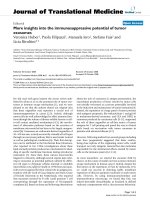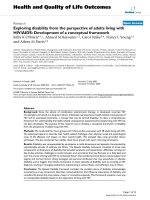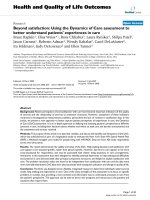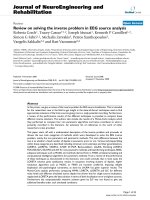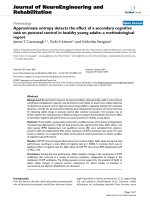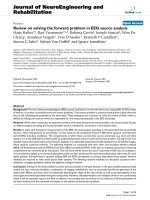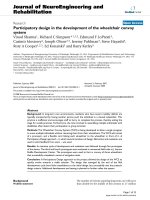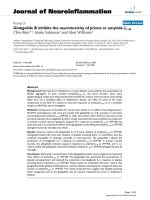báo cáo hóa học:" Compressive loading at the end plate directly regulates flow and deformation of the basivertebral vein: an analytical study" docx
Bạn đang xem bản rút gọn của tài liệu. Xem và tải ngay bản đầy đủ của tài liệu tại đây (294.49 KB, 6 trang )
BioMed Central
Page 1 of 6
(page number not for citation purposes)
Journal of Orthopaedic Surgery and
Research
Open Access
Research article
Compressive loading at the end plate directly regulates flow and
deformation of the basivertebral vein: an analytical study
Ming-Long Yeh
1,2
, Michael H Heggeness
1
, Hsiang-Ho Chen
1
,
Jennifer Jassawalla
1
and Zong-Ping Luo*
1
Address:
1
Department of Orthopedic Surgery, Baylor College of Medicine, Houston, TX, USA and
2
Biomedical Engineering Institute, National
Cheng-Kung University, Tainan, Taiwan, ROC
Email: Ming-Long Yeh - ; Michael H Heggeness - ; Hsiang-Ho Chen - ;
Jennifer Jassawalla - ; Zong-Ping Luo* -
* Corresponding author
Abstract
Background: Metastatic diseases and infections frequently involve the spine. This is the result of
seeding of the vertebral body by tumor cells or bacteria delivered by venous blood from Batson's
plexus, which is hypothesized to enter the vertebral body via the epidural veins. Isolated spinal
segments deform significantly at the bony end plate when under compression. This deformation
could cause a volume change of the vertebral body and may be accompanied by retrograde flow of
venous blood. To date, this process has not been investigated quantitatively. The purpose of this
study was to determine the volume changes of the vertebral body and basivertebral vein for a
vertebral body under compression.
Methods: A three-dimensional finite element mesh model of the L4 segment with both adjacent
discs was modified from a 3-D computed tomography scan image. An octagon representing the
basivertebral vein was introduced into the center of the vertebral body in the model. Four
compressive orientations (1500 N) were applied on the top disc. The volume change of the
vertebral body model and the basivertebral vein were then computed.
Results: The volume change of the vertebral body was about 0.1 cm
3
(16.3% of the basivertebral
vein) for the four loading conditions. The maximum cross-sectional area reductions of the
basivertebral vein and volume reduction were 1.54% and 1.02%, for uniform compression.
Conclusion: Our study quantified the small but significant volume change of a modeled vertebral
body and cross-sectional areas and that of the basivertebral vein, due to the inward bulging of the
end plate under compression. This volume change could initiate the reverse flow of blood from the
epidural venous system and cause seeding of tumors or bacterial cells.
Background
It is well-known that the venous drainage network for the
bony vertebral column is unique [1-4]. The caliber of the
basivertebral veins of the vertebral body is far out of pro-
portion to similar venous drainage systems for other
bones of the body, including large weight-bearing bones
[1,5]. Venous blood drains from the basivertebral vein
into the epidural system via the central vascular foramen
Published: 27 December 2006
Journal of Orthopaedic Surgery and Research 2006, 1:18 doi:10.1186/1749-799X-1-18
Received: 11 April 2006
Accepted: 27 December 2006
This article is available from: />© 2006 Yeh et al; licensee BioMed Central Ltd.
This is an Open Access article distributed under the terms of the Creative Commons Attribution License ( />),
which permits unrestricted use, distribution, and reproduction in any medium, provided the original work is properly cited.
Journal of Orthopaedic Surgery and Research 2006, 1:18 />Page 2 of 6
(page number not for citation purposes)
of the vertebral body. This blood then enters the highly
compliant epidural system which is continuous with the
valveless network of Batson's plexus [1].
Metastatic disease and infections frequently involve the
spine. This is widely believed to be the result of seeding of
the vertebral body by tumor cells or bacteria delivered to
the vertebral body by venous blood from Batson's plexus,
which is hypothesized to enter the vertebral body via the
epidural veins [1-3,6-9]. It has been proposed that during
daily activities such as straining, coughing, or lifting with
the upper extremity, blood is not only prevented from
entering the thoracicoabdominal cavity, it is actually
squeezed out of the cavity. Tumors and abscesses of the
thoracicoabdominal viscera and retroperitoneal space
connected with the Batson's plexus may therefore be shed
out from the cavity and distributed anywhere along the
vertebral system of veins [1,7]. If this widely held belief is
correct, then some retrograde flow of blood within the
vertebral body must take place to allow intraosseus entry
of bacteria or tumors. The large caliber of the basivertebral
vein and the flexible epidural system therefore presents an
appropriate anatomic accommodation for the volumes of
venous blood which must enter and exit the vertebral
body with each cycle of loading, allowing for possible
intermittent retrograde flow. We speculate that large end
plate deformation under normal physiological loading
observed from experimental studies [10,11] could cause a
volume change of the vertebral body. This volume change
is accommodated by antegrade and retrograde flow of
venous blood in and out of the valveless epidural vein sys-
tem, which is continuous with Batson's plexus.
Previous works have shown that isolated spinal motion
segments, when subjected to axial load, deform signifi-
cantly at the bony end plate [10-17]. If endplate deflection
of the vertebral body is a significant mechanism for axial
compression in the spine, the volume change within the
vertebral bones may occur concomitantly. The spine is
constantly subjected to intermittent compressive loading
during daily activities. Since compressive motion of the
spine occurs naturally in a rapid manner, this action
requires some means for the rapid accommodation of
these volume changes. This may be accomplished by the
flow of venous blood. To date, the volume change of the
venous vessel has not been investigated.
We hypothesize that volume within the vertebral body is
directly regulated by the compressive loading applied on
the end plate. The volume changes within the vertebra
under compressive loading could be accommodated by
the blood volume and flow of the basivertebral vein with
antegrade and retrograde flow of venous blood in and out
of the valveless epidural vein system. The volume change
of the vertebral body directly altering the total volume of
the intraosseous blood vessel could be one of the driving
forces for this reverse flow of the vertebral venous system.
In this study, we examined the volume change of the ver-
tebral body under different loading conditions using
finite element analysis, and the cross-sectional area and
volume changes of the basivertebral vein were calculated
to verify the hypothesis.
Methods
A three-dimensional finite element mesh model (ALGOR
Inc, Pittsburgh, PA) of the adult L4 segment with both
adjacent discs modified from a 3-D computed tomogra-
phy (CT) scan image of an adult spine was downloaded
from Finite Element Meshes Repository of the Interna-
tional Society of Biomechanics (Fig. 1). The spinal geom-
etry is symmetrical to the medial plane, so only half of the
structure is necessary for the models under uniform, ante-
rior and posterior compression conditions. An octagon
representing the basivertebral vein was introduced into
the center of the vertebral body. The geometry of the ver-
tebral body was divided into cortical shell, hard and soft
cancellous bone, and cartilaginous end plate. The iso-
tropic material properties (elastic modulus and Poisson's
ratio) of the cortical shell (14.5 GPa, ν = 0.3), hard (227
MPa, ν = 0.3) and soft (113 MPa, ν = 0.3) cancellous bone,
cartilaginous end plate (24.5 MPa, ν = 0.3), and disc
annulus (6.5 MPa, ν = 0.3) were applied to the geometry
[13]. Because of the highly porous structure of cancellous
bone, the Poisson's ratio could be smaller than 0.3. There-
fore, Poisson's ratio for cancellous bone (0.1) was also
used.
The end plate deflection of the vertebral segment was very
sensitive to the accuracy of the thickness of the cortical
shell because the modulus difference between cortical and
cancellous bone was 50 to 100 times. The thickness of the
cortical shell from the original CT scan image might not
well represent its real value. For confirming the model in
this study, the end plate deflection of the vertebral seg-
ment under uniform compression was matched to the
previous experimental data by deliberately adjusting the
thickness of the cortical shell.
Four loading conditions were simulated with a compres-
sive force of 1500 N applied on the top disc: uniform, lat-
eral portion, anterior portion, and posterior portion. The
bottom disc was fixed. The deformations of the end plate,
vertebral body, and basivertebral vein were calculated.
The change of the vertebral body volume and cross-sec-
tional areas along the basivertebral vein and its volume
were computed.
Journal of Orthopaedic Surgery and Research 2006, 1:18 />Page 3 of 6
(page number not for citation purposes)
Results
The deflection, or inward bulging, at the center of the ver-
tebral endplate was 0.185 mm when the thickness of the
bony endplates was modified from 1 mm to 0.4 mm. It
was compared to the studies using experimental measure-
ments under the same loading condition with good agree-
ment [10,12].
The volume decreases in the vertebral body were 0.102
cm
3
(0.35%), 0.110 cm
3
(0.37%), 0.092 cm
3
(0.31%) and
0.107 cm
3
(0.36%) for uniform, anterior, posterior, and
lateral loading, respectively (Table 1). The volume change
increased to 0.130 cm
3
, 0.142 cm
3
, 0.114 cm
3
, and 0.138
cm
3
for uniform, anterior, posterior, and lateral loading,
respectively, as Poisson's ratio for cancellous bone (0.1)
was used (Table 1).
The cross-sectional area changes of the basivertebral vein
were affected by the loading conditions and locations of
the vein. The cross-sectional area deformed differently at
various segments of the basivertebral vein (Fig. 2). The
maximum cross-sectional area reductions of the vein near
the center of the vertebral body were 1.54%, 1.96%,
1.53% and 1.69% of the original cross-sectional areas for
uniform, anterior, posterior and lateral loading, respec-
tively (Table 2). The reductions of the cross-sectional areas
at the posterior exit of the basivertebral vein were less than
0.28% in all loading conditions.
The volume changes in the basivertebral vein were influ-
enced by the loading conditions. The original volume of
the basivertebral vein in this model was 0.62655 cm
3
. The
volume decrements of the basivertebral vein were 1.02%,
1.14%, 0.82%, and 1.08% of the original volume of the
basivertebral vein for uniform, anterior, posterior and lat-
eral loading, respectively (Table 2).
Discussion
Our study found that the volume decrease for the verte-
bral body was larger than 0.1 cm
3
, and the reduction ratio
of the volume of the basivertebral vein was about 1%
when the vertebral body was under 1500 N axial compres-
sion. Although the percentage volume reduction of the
basivertebral vein was not large, the percentage of the ver-
tebral body volume change to the volume of the basiver-
tebral vein in this model could be up to 17.5% (0.11 cm
3
to 0.62655 cm
3
) for anterior compression. The deforma-
tion of the vertebral body could be accommodated by the
blood flow in and out of its basivertebral venous system.
Conversely, the vertebral body and basivertebral vein
would expand when the loading was removed. The cross-
sectional area change of the basivertebral vein at the pos-
terior exit, less than 0.28%, was significantly less than at
the center (1.53% to 1.96%) for various loading condi-
tions.
The deformation for posterior loading was less significant
because the compression was resisted by the spinous proc-
ess. This implied that it is easier to create a blood vessel
volume change during spine flexion than during exten-
sion.
Table 1: Vertebral body volume changes under different loading and Poisson's ratio (0.3, 0.1) for cancellous bones.
(ν = 0.3) (ν = 0.1)
Loading cm
3
%cm
3
%
Uniform -0.102 -0.35% -0.130 -0.44%
Anterior -0.110 -0.37% -0.142 -0.48%
Posterior -0.092 -0.31% -0.114 -0.39%
Lateral -0.107 -0.36% -0.138 -0.47%
Finite element model of L4 vertebra under uniform compres-sion at the top of the discFigure 1
Finite element model of L4 vertebra under uniform compres-
sion at the top of the disc. The spinal geometry is symmetri-
cal to the medial plane, so only half of the structure is needed
to model uniform, anterior and posterior compression con-
ditions.
Journal of Orthopaedic Surgery and Research 2006, 1:18 />Page 4 of 6
(page number not for citation purposes)
Previous studies have shown significant changes in verte-
bral body pressure according to posture and position,
with increased intervertebral pressures reproduced by pos-
tures that increased axial load, a phenomenon that is not
seen in weight-bearing long bones [5,18,19]. Axial com-
pression at the vertebral body causing significant end
plate deflection was observed by experimental measure-
ment [10,12]. This study further computed the vertebral
body and venous blood vessel volume change under the
axial loading that caused similar end plate deformation.
The direct accommodation of the volume change of the
basivertebral vein for the vertebral body under compres-
sion would be a flow of venous blood. The volume of the
basivertebral vein only slightly changed (1%); however,
the volume change of the vertebral body compared to the
basivertebral vein was significant (17.5%). The volume
change of the vertebral body under compression could
result from the compressibility of the solid phase of corti-
cal and cancellous bones themselves; however, the vol-
ume change could also be accompanied by intraosseous
flow. The pressure applied at the end plate is over 100
times higher than intraosseous pressure. The nature of the
highly porous structure of cancellous bone causes most of
the accompanying deformation of the vertebral body by
squeezing the space among the solid bony materials, i.e.
constricting the flow of blood inside it. The volume
change of the vertebral body under uniform compression
was about 16.3% of the volume of the basivertebral vein;
thus, almost 1/6 of the blood inside the basivertebral vein
was turned over under single compressive loading. Com-
bining the deformation of the vertebral body and the
basivertebral vein, the spinous venous system would func-
tion as a sucking device to retract the blood into the spine
when the compression on the vertebral body was quickly
released. This result would explain the mystery of a high
incidence of tumor or bacterial seeding of the spine on the
basis of a pumping action on the venous blood, powered
by reversible endplate deflection.
Cross-sectional area reduction along the basivertebral veinFigure 2
Cross-sectional area reduction along the basivertebral vein.
Table 2: The cross-sectional area and volume changes at the basivertebral vein under different loading conditions.
Loading Area Volume
Center Posterior cm
3
%
Uniform -1.54% -0.16% -0.0064 -1.02%
Anterior -1.96% -0.03% -0.0071 -1.14%
Posterior -1.53% -0.28% -0.0051 -0.82%
Lateral -1.69% -0.14% -0.0068 -1.08%
Journal of Orthopaedic Surgery and Research 2006, 1:18 />Page 5 of 6
(page number not for citation purposes)
The Poisson's ratio used in the model directly affected the
compressibility of the material. The volume change of the
vertebral body under uniform compression for Poisson's
ratio (0.3) of cancellous bone used in this model was
0.102 cm
3
. It increased to 0.130 cm
3
when the Poisson's
ratio was 0.1. The in vivo actual Poisson's ratio of the bony
material is difficult to calculate because of the inclusion of
the liquid phase of blood and fluid and their irrigation
within the vertebral body. However, 0.3 Poisson's ratio
should be a conservative estimation. The volume change
of the vertebral body under uniform compression was
about 16.3% of the volume of the basivertebral vein using
Poisson's ratio (0.3) for cancellous bone. This percentage
of volume change for vertebra under rapid loading and
unloading should be the driving force to generate the ret-
rograde flow of basivertebral blood flow.
One of the advantages of this finite element method is the
ability to calculate the profile of the cross-sectional area
change along the basivertebral vein. The direct assessment
of the reduction of the basivertebral vein cross-sectional
area by experimentation remains challenging. In a previ-
ous finite element study, the vertebral body of the two-
dimensional model was assumed to be axially symmetri-
cal, and the venous vessel was not included [13]. In our
study, the profile of the cross-sectional area change along
the entire basivertebral vein was calculated, as was the vol-
ume change of the vertebral blood vessel. The deforma-
tion distribution along the blood vessel matched the
bulging at the end plate. The blood vessels near the surface
of the vertebral body are surrounded by a cortical bony
shell, so the cross-sectional area change of the basiverte-
bral vein at its surface exit was much less than at its center
(Table 2). Although it would be easier to measure the
change of the cross-sectional area of the basivertebral vein
at the bony surface under loading, using this value to pre-
dict the volume change of the venous vessel would under-
estimate the actual volume changes within the vertebral
body.
To our knowledge, this is the first theoretical simulation
to elucidate the correlation between the loading at the spi-
nal body and the high incidence of seeding of tumor cells.
Limitations exist in some aspects of the model: (1) the
geometry and material properties of the vertebral body
and (2) the shape of the spinal venous system [1]. The
human spine is a complex biological structure which con-
sists of alternating cortical and cancellous bony compo-
nents. The elastic modulus of cortical bone is about 100
times higher than cancellous bone. The deformation of
the bony segment is very sensitive to the accuracy of the
dimension of the cortical end plate. The geometry in this
model was obtained from a 3-D CT image; however, the
thickness of the cortical bone in the original CT image
might not precisely represent the true dimension of the
bony end plate in individual human patients. The effects
of osteoporosis on this system, for example, are not
known. However, osteoporosis would be predicted to
increase the deflections studied herein. The finite element
model in this study was carefully evaluated before its use.
End plate deflection has been measured by cadaveric stud-
ies yielding results consistent with those of this study
[10,12]. The thickness of the cortical shell in our study
was carefully adjusted from 1 mm to 0.4 mm to match the
end plate deformation from previous studies.
The blood vessel was modeled using an octagonal shape
inserted through the vertebral body. Although the basiver-
tebral vein is only present at a portion of the vertebral
body, the combination of the upstream small veins and
capillaries might deform equivalently to a single large
blood vessel inside the vertebral body. In the future, more
detailed geometry representing the circulatory system
inside the vertebral body and the amount of pressure
change in response to the blood vessel volume change
needs to be studied.
In summary, our study quantified the small but signifi-
cant volume change of the vertebral body and the cross-
sectional areas and volume change of the basivertebral
vein due to the inward bulging of the end plate under
compression. This high ratio of volume change of the ver-
tebral body to the volume of the blood vessel could initi-
ate reverse blood flow from the epidural venous system
and cause seeding of vertebral bone tumors or bacterial
cells.
Competing interests
The author(s) declare that they have no competing inter-
ests.
Authors' contributions
MLY assembled the computer models and images, col-
lected the data and compiled the manuscript. MHH con-
tributed clinical expertise and input regarding the
pathology of spinal tumors and physiology of the spinal
venous drainage. HHC provided biomechanical expertise
regarding the experimental design. JJ assisted with the
computer modeling and data collection. ZPL assisted with
the research design, data analysis and writing of the man-
uscript. All authors read and approved the final manu-
script.
References
1. Batson OV: The function of the vertebral veins and their role
in the spread of metastases. 1940. Clin Orthop 1995, 312:4-9.
2. Crock HV, Yoshizawa H, Kame SK: Observations on the venous
drainage of the human vertebral body. J Bone Joint Surg Br 1973,
55:528-533.
3. Dommisse GF, Grobler L: Arteries and veins of the lumbar
nerve roots and cauda equina. Clin Orthop 1976, 115:22-29.
Publish with BioMed Central and every
scientist can read your work free of charge
"BioMed Central will be the most significant development for
disseminating the results of biomedical research in our lifetime."
Sir Paul Nurse, Cancer Research UK
Your research papers will be:
available free of charge to the entire biomedical community
peer reviewed and published immediately upon acceptance
cited in PubMed and archived on PubMed Central
yours — you keep the copyright
Submit your manuscript here:
/>BioMedcentral
Journal of Orthopaedic Surgery and Research 2006, 1:18 />Page 6 of 6
(page number not for citation purposes)
4. Crock HV, Yoshizawa H: The blood supply of the lumbar verte-
bral column. Clin Orthop 1976, 115:6-21.
5. Hanai K, Kawai K, Itoh Y, Satake T, Fujiyoshi F, Abematsu N: Simul-
taneous measurement of intraosseous and cerebrospinal
fluid pressures in lumbar region. Spine 1985, 10:64-68.
6. Wiley AM, Trueta J: The vascular anatomy of the spine and its
relationship to pyogenic vertebral osteomyelitis. J Bone Joint
Surg Br 1959, 41-B:796-809.
7. Oeppen RS, Tung K: Retrograde venous invasion causing verte-
bral metastases in renal cell carcinoma. Br J Radiol 2001,
74:759-761.
8. Oge HK, Aydin S, Cagavi F, Benli K: Migration of pacemaker lead
into the spinal venous plexus: case report with special refer-
ence to Batson's theory of spinal metastasis. Acta Neuro-
chir(Wien) 2001, 143:413-416.
9. Nishijima Y, Uchida K, Koiso K, Nemoto R: Clinical significance of
the vertebral vein in prostate cancer metastasis. Adv Exp Med
Biol 1992, 324:93-100.
10. Brinckmann P, Grootenboer H: Change of disc height, radial disc
bulge, and intradiscal pressure from discectomy. An in vitro
investigation on human lumbar discs. Spine 1991, 16:641-646.
11. Heggeness MH, Doherty BJ: Discography causes end plate
deflection. Spine 1993, 18:1050-1053.
12. Brinckmann P, Frobin W, Hierholzer E, Horst M: Deformation of
the vertebral end-plate under axial loading of the spine. Spine
1983, 8:851-856.
13. Suwito W, Keller TS, Basu PK, Weisberger AM, Strauss AM, Spengler
DM: Geometric and material property study of the human
lumbar spine using the finite element method. J Spinal Disord
1992, 5:50-59.
14. McNally DS, Adams MA: Internal intervertebral disc mechanics
as revealed by stress profilometry. Spine
1992, 17:66-73.
15. Holmes AD, Hukins DW, Freemont AJ: End-plate displacement
during compression of lumbar vertebra-disc-vertebra seg-
ments and the mechanism of failure. Spine 1993, 18:128-35.
16. Knop C, Lange U, Bastian L, Oeser M, Blauth M: Biomechanical
compression tests with a new implant for thoracolumbar
vertebral body replacement. Eur Spine J 2001, 10:30-37.
17. Yingling VR, McGill SM: Mechanical properties and failure
mechanics of the spine under posterior shear load: observa-
tions from a porcine model. J Spinal Disord 1999, 12:501-508.
18. Arnoldi CC: Intraosseous hypertension. A possible cause of
low back pain? Clin Orthop 1976, 115:30-34.
19. Esses SI, Moro JK: Intraosseous vertebral body pressures. Spine
1992, 17:S155-S159.
